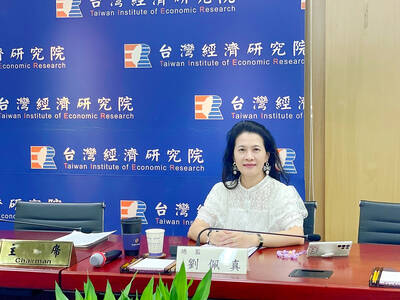Foxconn Technology Group (富士康科技集團) plans to acquire display start-up eLux Inc for about US$27.03 million in cash via four subsidiaries, including Sharp Corp, in an effort to accelerate its development of next-generation micro-LED display technology, company statements said on Monday.
The acquisition could provide a fast track for Foxconn — known as Hon Hai Precision Industry Co (鴻海精密) in Taiwan — to commercialize micro-LED technology, which industry experts say could exceed organic LED (OLED) technology.
Micro-LED shares traits with OLED, but costs less.
Foxconn’s latest move came as its top clients, Apple Inc and Sony Corp, have been investing in micro-LED in pursuit of an alternative to OLED technology, seeking similar energy efficiency and ultra-high-definition display advantages at cheaper costs.
Apple is expected to crank out a small volume of next-generation micro-LED displays for wearable devices from a plant in Taoyuan’s Longtan District (龍潭) by the end of this year, IDC analyst Annabelle Hsu (徐美雯) said in March.
Apple has placed more focus on micro-LED after acquiring LuxVue Technology Corp in 2014.
Foxconn’s Cyber Venture Capital Corp, Sharp, Innolux Corp (群創) and Advanced Optoelectronic Technology Inc (AOT, 榮創) have inked agreements to invest in eLux, Sharp and Innolux said in separate statements.
Following the investments, Cyber Venture will hold the biggest stake of 45.45 percent in eLux, while Sharp and Innolux will own 31.82 percent and 13.64 percent respectively, the statements said. AOT will hold 9.09 percent.
Sharp will acquire the rights to 21 patents developed by eLux, Sharp’s statement said.
“Cooperation between Innolux’s research and development team in Taiwan and eLux’s team in the US will help accelerate the development of next-generation display technology,” Innolux said in its statement.
The deal is expected to be completed in October, Sharp said.
ELux was established in October last year in Delaware, according to information provided by Sharp.
Taipei-based TrendForce Corp (集邦科技) said that micro-LED technology is to have a market value of between US$30 billion and US$40 billion per year once it fully replaces mainstay LCD technology.
The new technology is expected to become mainstream in three to five years, TrendForce said.
The manufacturing costs of micro-LED panels are still high, about three to four times their LCD equivalents, it said.
IDC said it expects micro-LED to become commercially available in 2020.
Micro-LED panels are suitable for smartphones and virtual-reality or augmented-reality devices due to the high demand for picture quality demanded by those products, TrendForce said.

A proposed 100 percent tariff on chip imports announced by US President Donald Trump could shift more of Taiwan’s semiconductor production overseas, a Taiwan Institute of Economic Research (TIER) researcher said yesterday. Trump’s tariff policy will accelerate the global semiconductor industry’s pace to establish roots in the US, leading to higher supply chain costs and ultimately raising prices of consumer electronics and creating uncertainty for future market demand, Arisa Liu (劉佩真) at the institute’s Taiwan Industry Economics Database said in a telephone interview. Trump’s move signals his intention to "restore the glory of the US semiconductor industry," Liu noted, saying that

On Ireland’s blustery western seaboard, researchers are gleefully flying giant kites — not for fun, but in the hope of generating renewable electricity and sparking a “revolution” in wind energy. “We use a kite to capture the wind and a generator at the bottom of it that captures the power,” said Padraic Doherty of Kitepower, the Dutch firm behind the venture. At its test site in operation since September 2023 near the small town of Bangor Erris, the team transports the vast 60-square-meter kite from a hangar across the lunar-like bogland to a generator. The kite is then attached by a

Foxconn Technology Co (鴻準精密), a metal casing supplier owned by Hon Hai Precision Industry Co (鴻海精密), yesterday announced plans to invest US$1 billion in the US over the next decade as part of its business transformation strategy. The Apple Inc supplier said in a statement that its board approved the investment on Thursday, as part of a transformation strategy focused on precision mold development, smart manufacturing, robotics and advanced automation. The strategy would have a strong emphasis on artificial intelligence (AI), the company added. The company said it aims to build a flexible, intelligent production ecosystem to boost competitiveness and sustainability. Foxconn

Leading Taiwanese bicycle brands Giant Manufacturing Co (巨大機械) and Merida Industry Co (美利達工業) on Sunday said that they have adopted measures to mitigate the impact of the tariff policies of US President Donald Trump’s administration. The US announced at the beginning of this month that it would impose a 20 percent tariff on imported goods made in Taiwan, effective on Thursday last week. The tariff would be added to other pre-existing most-favored-nation duties and industry-specific trade remedy levy, which would bring the overall tariff on Taiwan-made bicycles to between 25.5 percent and 31 percent. However, Giant did not seem too perturbed by the